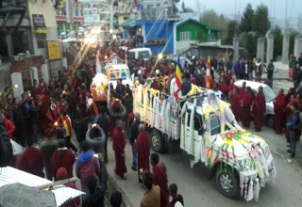
By Joan Martinez-Alier.
Public protests against the construction of dams in the Tawang district of Arunachal Pradesh in North East India have been going on for some years. In the whole state there are grandiose plans for producing 50 000 MW of electricity. Little of this has yet been built.
On 2 May 2016 (as reported in The Wire, The Telegraph and other media on 3 May) things took a deadly turn. At least two protesters lost their lives in police firing and others were seriously injured. China borders on Tawang, a 2085 square km patch where in 1962 the Chinese army marched in. Tawang was historically part of Tibet. The 1914 Simla Accord defined the McMahon line as the new boundary between British India and Tibet. By this treaty, Tibet relinquished several thousand square miles of its territory, including Tawang, to the British. But the treaty was not recognised by China. Today, the problems also have to do with dams and not only with the border.
Tawang is home to the Monpa people. It is a tourist destination thanks to the well-preserved Tawang Monastery and a seat of Tibetan Buddhism. Since 2011 it has been witness to public protests against the state government’s decision to set up many dams across the district. The protests are being driven by environmental and religious concerns. Reportedly, 13 of the over 150 hydroelectric projects planned by the state since 2005 are in Tawang. To stall this spree of dam construction, people from the Monpa community joined hands with local Buddhist monks in 2011 to form the Save Mon Region Federation (SMRF).
The National Green Tribunal (NGT) had recently, on April 7th 2016, suspended the environmental clearance of the 780 MW, 840 million euro Nyamjang Chhu project in response to an appeal filed by the Save Mon Region Federation. The Tribunal had asked for new impact assessment studies, public hearings for local people and appraisal by the Expert Appraisal Committee on River Valley & Hydroelectric projects and the Ministry of Environment, Forests and Climate Change (MoEFCC). A major issue was the impact on the wintering habitat of the Black-necked crane, a vulnerable bird considered sacred by the Monpa people.They see it the bird as an embodiment of the 6th Dalai Lama who was from Tawang and wrote about the bird in his poetry.
The National Green Tribunal is playing a good role for the environment in India. Very recently it has also decided against one hydroelectric dam in Himachal Pradesh (at the west end of the India Himalayas), in the sense that decisions should be subject to previous approval by the gram sabha, the local assemblies. (As it was for bauxite mining in the Vedanta case in the Niyamgiri case in Odisha, some years ago).
The NGT noted that the project in Arunachal Pradesh – promoted by the Noida-based steel conglomerate LNJ Bhilwara Group – did not consider its impact on the habitat of the black-necked crane, which is endemic to the region. The bird is rated “vulnerable” in the International Union for Conservation of Nature’s list of endangered species and is listed in schedule 1 of the Wildlife (Prohibition) Act 1972.
SMRF general secretary Lama Lobsang Gyatso said, “The NGT’s decision to suspend work on the project has led those with vested interest in the state to suddenly look at us as a powerful enemy.” Corruption is also alleged. According to Gyatso, “it is clear to the local people that while somebody powerful is making money on these projects, they have not only been unable to provide electricity but are also degrading the environment they live in”.
The week before May 2, Gyatso was arrested twice for reasons he said are “linked to not only the NGT decision but also our plan to take legal recourse for other hydro projects.” He explained that he had been in the lock-up of the Tawang police station since his re-arrest on April 28. On May 2, he was taken to the court of the district magistrate for hearing on his bail application. A large number of villagers and lamas assembled in front of the police station seeking his release. He was denied bail. Many villagers and lamas had already been angry at the biased attitude of the district administration. On knowing about the denial of bail, the crowd began moving towards the police station. They were then fired upon with live bullets. No tear gas and no rubber bullets were used. One of the deceased was hit on the forehead. Among the dead, a woman was yet to be identified. The other deceased seems to have been a student of the Tawang monastery, Lama Nima Wangde. By mid-afternoon, prohibitory orders under Section 144 were clamped on Tawang town and the army was called in to stage a flag march. It was reported that Chief Minister Kalikho Pul, who was in New Delhi, ordered a judicial inquiry into the firing. Pul also announced 6600 euro ex-gratia payment to the families of those killed.
There is a clear intention by the goverment and some of the media to downplay the “unfortunate incident”.
More info
The Atlas of Environmental Justice has 55 dam and water distribution conflicts in India alone. Find out more on http://ejatlas.org/

The project ENVJUSTICE has received funding from the European Research Council (ERC) under the European Union’s Horizon 2020 research and innovation programme (grant agreement No. 695446)